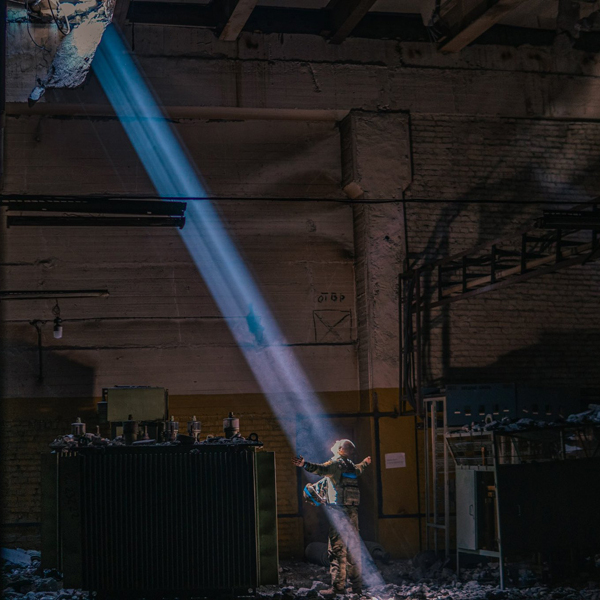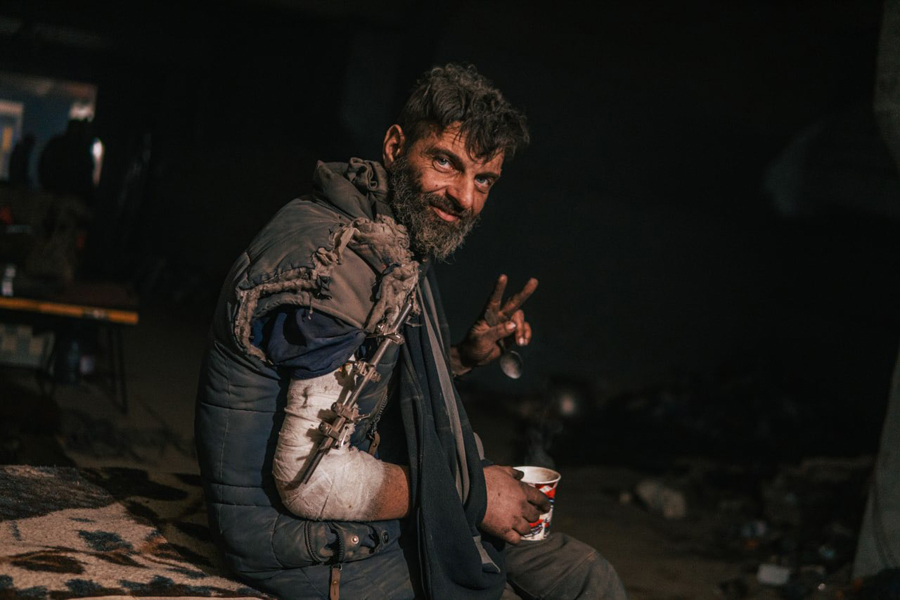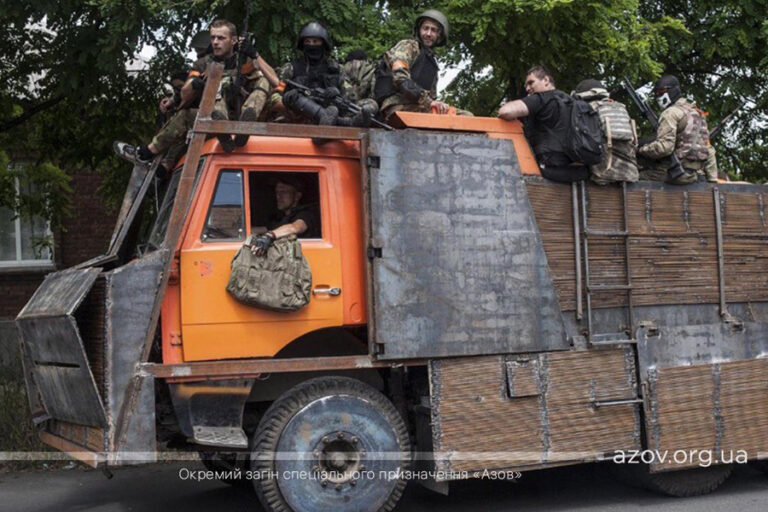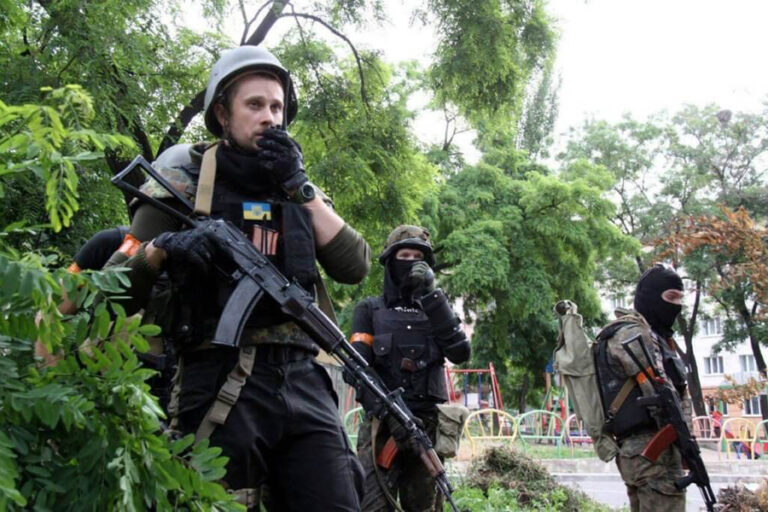
When announcing the invasion of Ukraine, Putin proclaimed “denazification” as one of the ultimate goals of his “special military operation”. To most people around the world, this sounded like absolute nonsense, a claim founded solely based on Putin’s sick imagination that has nothing to do with the reality in Ukraine. However, just as Russia’s plan to invade Ukraine had been in preparation for years, so was its effort to build justifiable grounds for the war in the eyes of the Russian citizens and people around the world. A big part of that endeavour was creating a persuasive story about neo-Nazism in Ukraine (a challenging thing to invent about a country where far-right parties get less than 3% of the vote in elections and have no political power).
The entire Russian story about Nazis in Ukraine hangs by a single thread connected to the Azov Regiment, a unit of the National Guard of Ukraine. This story became so persuasive that even 100 days into the full-scale Russian invasion of Ukraine, some people were still asking, “Are members of the Azov Regiment really neo-Nazis?” To answer this question and understand why this image of the military unit is still circulating in the media and among the Western public, we have to look into the history of Azov and how it has been portrayed in the media, both before and during the full-scale war.
History of Azov

Following the illegal occupation of Crimea in 2014, Russia orchestrated a separatist uprising in Donetsk and Luhansk and, consequently, invaded the east of Ukraine. Underfunded under the pro-Russian then-president Yanukovych and structurally corrupt, the Ukrainian Armed Forces weren’t able to properly respond to the invasion. Civilian volunteers, who had previously stood up to the pro-Russian regime during the Maidan Revolution, mobilized to fill the gap in the country’s defence capabilities. Many volunteer battalions were established in response to Russian aggression, including Azov (named after the Sea of Azov, which is bordered by the Donetsk, Zaporizhzhia and Kherson regions in the south of Ukraine). The core of the unit consisted of fans of the Kharkiv-based football club Metalist, activists from ‘Automaidan’ (a car-based protest movement during the Maidan Revolution – ed.), and members of several Kharkiv-based far-right groups such as the Patriot of Ukraine as well as members of the Social Nationalist Assembly (SNA). Both the Patriot and the SNA were led by Andriy Biletskyi (more on him later).

After participating in the liberation of Mariupol from separatists and Russian forces in May-June 2014, Azov established a strong reputation among the Ukrainian public and started attracting more volunteers. One of the common myths about the unit is that it is a militia group (defined as a military force that operates on a temporary basis and whose members are not soldiers in a permanent army). However, this is false. In the fall of 2014, Azov was integrated into the National Guard under command of the Ministry of Internal Affairs of Ukraine and permanently stationed in Mariupol.
slideshow
When the full-scale Russian invasion began in 2022, Azov played a major role in fighting off Russian forces in the south of Ukraine. For 86 days, they resisted the occupying forces alongside members of a subdivision of the 36th separate marine brigade of Mykolaiv. In the last month, Ukrainian fighters were pushed inside the territory of a massive steel plant called Azovstal. Despite the constant bombardment, artillery shells and superior attacking positions, Russian forces were never able to fully take over the plant. Because of a shortage of food, water and critical medical supplies, the soldiers of Azov and marines were ordered to surrender by the Ukrainian government on May 19. On June 29, 43 Azov members returned to Ukraine during a prisoner exchange but, as of July 2022, more than 2,500 Ukrainian defenders of Mariupol are still being held captive by Russia.

The origins of the neo-Nazi story
In Ukraine, the significance of Azov is directly tied to its efforts in defending Mariupol in 2014 and during the full-scale invasion of 2022. Aside from their military service, especially before 2022, Azov members have rarely been discussed in public. Unsatisfied with the pro-European and pro-democratic movement in Ukraine in 2014, Russia started claiming that the legitimate government of Ukraine had been overthrown by a “fascist” or “neo-Nazi junta”. The international media quickly picked up this story and capitalized on it, discussing whether the Kremlin had any grounds for such statements. Vyacheslav Likhachev, the head of the National Minority Rights Monitoring Group and a member of the expert council of Ukraine’s Centre for Civil Liberties who has been studying far-right radicalism, describes the extensive coverage of Azov as a vicious cycle. “The media attention feeds itself: the media write about Azov precisely and, for the most part, only because the media writes about Azov. It’s just an obsession that is not worth responding to.” Likhachev wrote in one of his op-eds on Azov. But are there any grounds for accusing Azov members of being neo-Nazis?

First, it is important to define what neo-Nazism actually means and how it differs from more widespread far-right political movements. While both share common ideas, such as conservative values, the supremacy of one race or ethnicity over others, law and order, and others, neo-Nazism is distinct in its aspirations to revive Nazi ideology in particular, following Hitler’s ideas about race and society. In other words, all neo-Nazis are far-right individuals, but not all far-right individuals are neo-Nazis. However, the lines between the two definitions can be blurred significantly by the media and one or the other can be used as a convenient narrative tool.

After all the nonsensical claims about secret biolabs and hidden nuclear weapons, as well as the denial of war crimes, it is clear that nothing that Russian TV presenters, political figures or government officials say should be taken as truth. In the case of Azov, the Russian media clung to the biographies of Azov’s founders and their participation in far-right movements in order to create a story claiming that the entire battalion is made up of neo-Nazis today, which is simply false. One of the founding members, Andriy Biletskyi, does in fact have a controversial background, but this does not define the current members of Azov, their political views and ideologies. Andriy Biletskyi, the chairman of the right-wing political party “National Corps”, who played a role in the formation of the Azov Battalion and is considered its founder, led the battalion for only a couple of months in 2014. Biletskyi returned to his political activity afterwards; however, some foreign media sources still spread the misinformation that it was Azov, not Biletskyi, who founded the “National Corps”. It’s important to mention that Biletskyi was a member of the Ukrainian parliament only from 2014 to 2019 and failed to get reelected again. Currently, his party has no political power in the country. Despite having left Azov a while ago, Biletskyi still considers it his “brainchild” and, according to Vyacheslav Likhachev, actively uses Azov’s “trademark” to advance his political career. During his time as an MP, Biletskyi founded the Azov Civil Movement, but it is crucial to note that all these political parties and movements founded by Biletskyi and his supporters are completely separate from Azov, a unit of Ukraine’s National Guard. It is also worth noting that military and law enforcement officers are not allowed to establish or be members of political parties in Ukraine.

Are the members of Azov neo-Nazis?

Most definitely not. While the initial far-right founders left the regiment by the end of 2014, the Russian propaganda machine and some Western media still use them to tarnish Azov’s reputation. It is not only wrong but also harmful to Ukraine to make such generalizing statements about an entire military unit that has evolved and changed over the years, based solely on the profiles of its founders. Discrediting Ukraine in the international arena is precisely the goal of the Russian media.
What’s more, military units in the Ukrainian Armed Forces cannot be formed on the grounds of any particular ideology. The only possible ideology of the National Guard is the Disciplinary Statute (which, incidentally, enshrines the obligation to “respect human rights, honour and dignity” and “refrain from statements and actions that violate human rights or degrade human honour and dignity”). The regiment often described as “full of white supremacists” is actually more diverse than most people think. Before and during the full-scale war, many representatives of ethnic and national minorities have served in Azov, including but not limited to Jews, Crimean Tatars, Moldovans and Georgians. According to Vyacheslav Likhachev, everyone who openly articulated extremist views was removed by the new command of Azov in 2017. Moreover, in a recent statement, Azov highlighted that it “despises Nazism and Stalinism”.

So, if everything is so obvious, why do the Western audiences continue to express concern about Azov?

Here is how Vyacheslav Likhachev explains it:
“Russian propaganda has fostered the impression of a criminal, neo-Nazi “nationalist battalion” that allegedly exists in Ukraine. Propagandists use objective facts (such as the political past of the battalion’s founders) to create an impressive picture. This picture is fake, but Russian propaganda should not be underestimated.
It is a systematic, professional, and convincing narrative — especially in Western society, which is not accustomed to such blatant lies. Western society typically rejects a black-and-white vision of the world and considers more complex models. Typically, this vision looks for the truth somewhere in the middle, between the polarized extremes. But as Polish historian Adam Michnik said, “The truth does not lie in the middle; it lies where it lies.”
Propaganda only works when you are willing to believe in it. If one internally agrees with propaganda, the convincing part is easy. It is convenient for the West to lull itself with fables that everything is complicated and ambiguous. In this case, there is no need to intervene and no need to feel guilty, the conscience is clear.
One reason the myth about Ukrainian Nazism is still viable is that it benefits not only Russia. This is a great argument for doing nothing, watching Ukraine fight alone with the enemy, and not feeling much sympathy for the fighters of Azov, many of whom were killed in an unequal battle, defending Mariupol with all their might, while others are now in Russian captivity.”




